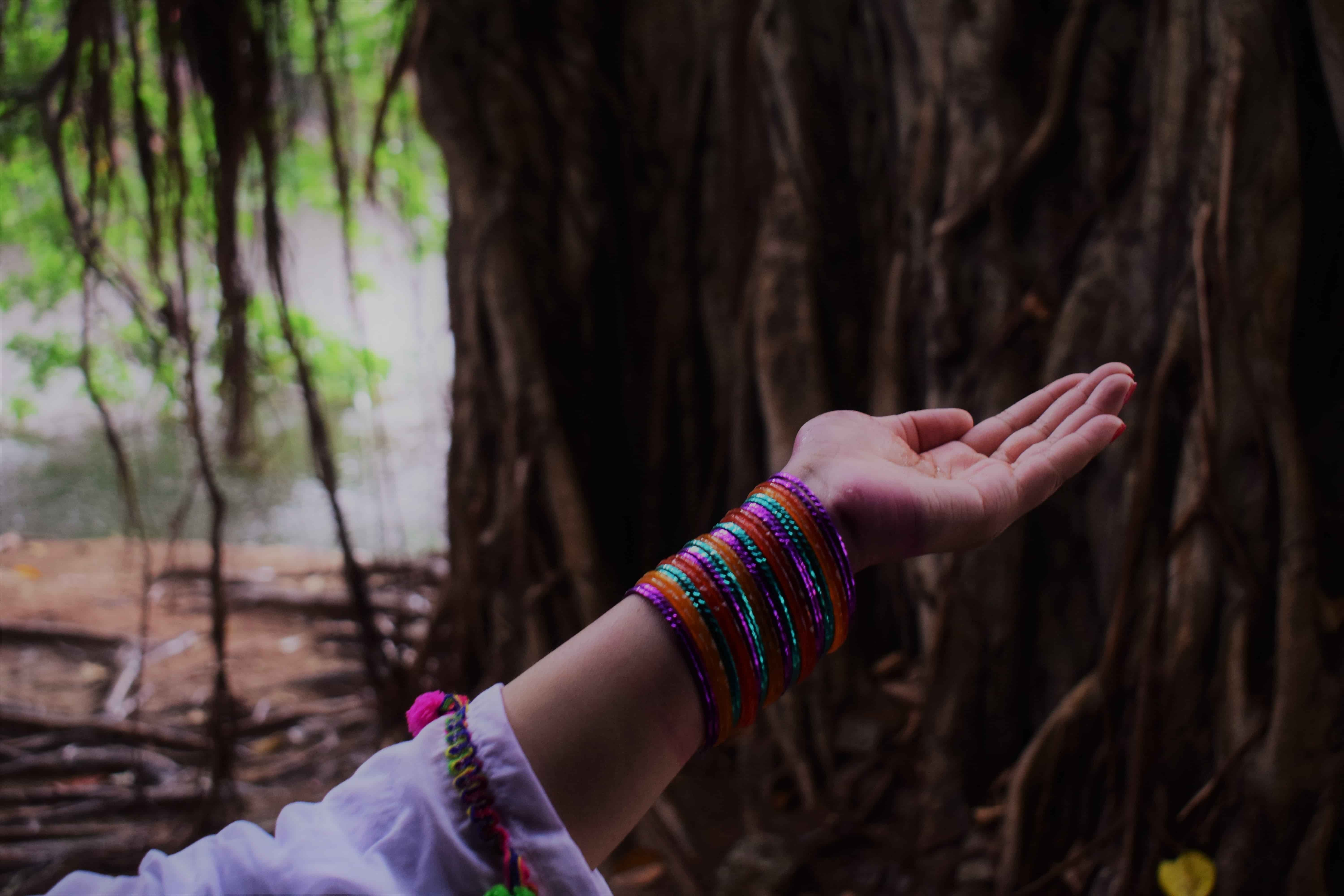The Bangle Sellers
The Bangle Sellers is a poem written by the Indian writer Sarojini Naidu. All you need to know and learn about this chapter is given below.

Share Options
Summary of the Poem
The poem ‘The Bangle Sellers‘ by Sarojini Naidu celebrates the hopes, values, and life of a typical Indian woman in the 1900s. The poem is written and has the tone of Indian folk lyrics. The poem uses bangles as symbols to represent the different stages in the life of an Indian woman. ‘The Bangle Sellers‘ is taken from the third section of Indian Folk songs in Naidu's second book, ‘The Bird of Time‘.
The poem presents the various stages of an Indian woman's life through a string of images associated with different colours of bangles. The bangle sellers are carrying ‘rainbow colour’ bangles to the temple fair. They invite the ladies to come and buy these delicate bright, rainbow colour bangles from them. The multiple hues of bangles are symbolic of the happy life of their daughters and wives.
Lustrous tokens of radiant lives,
For happy daughters and Happy wives.
In the second stanza, the bangle seller suggests suitable bangles for a maiden's wrist. They go on to suggest silver and blue coloured bangles as they remind them of the misty mountain. They also suggest bangles in the colour pink as it is an indication of the blooming phase in a maiden’s life. They also suggest bangles in the tone of the newborn leaves in the dew-filled mornings. The tones of green, pink, blue and silver are apt for the maiden’s wrist.
In the third stanza, the bangle sellers are describing the bangles that suit best for a bridal morning. These bangles have the hues of yellow like a field of corn and the hue of red like a flame.
Similar to the yearnings of a bride's heart, the vibrant hue of deep red is deemed suitable by the bangle sellers to adorn the bride. These bangles serve as emblems of the joy and sorrow that encompass a bride's wedding day. Therefore, they are crafted to be resplendent, delicate, transparent, and radiant.
In the final stanza, the bangle sellers suggest the bangles for middle-aged women. The colours like purple and gold suit them best as they are happy mothers and blessed wives.
Summer purple and gold flecked grey
For she who has journeyed through life midway...
Share Options
A Deeper Look At The Poem
Let us look at the themes and go beyond the text through a few questions.
Folklife
Sarojini Naidu, renowned for her lyrical prowess, skillfully incorporates Indian folklife into her verses, celebrating the joys, sorrows, and occupations of the people.
In her poem 'The Bangle Sellers,' she beautifully captures the different phases of a traditional Indian woman's life, symbolized by the array of coloured bangles. These bangles serve as a testament to the deep-rooted Indian culture.
Naidu seamlessly connects the concept of diverse colours to the various stages of a woman's life, effectively mirroring the experiences of ordinary Indian women. Through the vibrant voice and suggestions of the bangle seller, she exuberantly celebrates the portrayal of female life, adding a touch of joy to her poetic composition.
Celebration of Womanhood
In this poem, the poet brings female friendship and womanhood into focus, highlighting their significance. The setting of a temple fair serves as an occasion where women gather, emphasizing their coming together. As the poem progresses, the poet delves into the initial stage of traditional Indian womanhood, symbolized by blue and silver bangles. These bangles evoke the excitement and vibrancy associated with a young, unmarried girl.
Throughout the stanzas, the poet adeptly captures the richness and diversity of a woman's life. The rainbow-tinted bangles vividly portray the multifaceted nature of womanhood, reflecting its myriad shades and hues. The poet employs imagery such as the pink of yet-to-bloom flowers, the green of newborn leaves, and the blue and silver reminiscent of moist mountains to encapsulate the desires and aspirations of a maiden.
Moving on, the poem explores the hopes, desires, and dreams of a young married woman. The red bangles symbolize her wedding night and embody her passionate aspirations. Furthermore, the bright yellow bangles represent fertility, mirroring the symbolism of a fertile cornfield. These colours are specifically chosen to signify a new bride's journey.
Lastly, the poet celebrates middle-aged women, who represent contentment and a fulfilled family life. The colours golden, silver, and purple hold symbolic significance, representing trust, wisdom, and care—the pillars that shape the life of a married woman in her middle years.
Through this poem, the poet artfully portrays the stages of a woman's life, depicting the beauty, aspirations, and roles that define her journey from maidenhood to marriage and maturity.
Poem: Form and Structure
Imagery
In this poem, the poet skillfully employs the use of different coloured bangles to represent various aspects and emotions of life, creating a vivid tapestry of traditional Indian women's experiences.
The initial mention of rainbow-tinted bangles symbolizes the dreams, youthfulness, aspirations, and hopes of women. It portrays the vibrant and optimistic outlook of young individuals.
The presence of purple-coloured bangles adorned with gold and grey signifies both the middle-age crisis and joy experienced by women. Purple, a colour associated with power, pride, authority, and dignity, reflects the multifaceted nature of this phase of life. The gold-flecked grey hints at wisdom and experience acquired over time.
To enhance the poem, the poet skillfully incorporates auditory imagery, such as mentioning "bridal laughter" and the delightful sound of bangles "tinkling." These auditory cues bring the poem to life and evoke a sense of celebration and joy.
Furthermore, the poem utilizes visual imagery, specifically the imagery of mountain mist, to portray the enchanting blue and silver tones of the bangles. The hopes and joys associated with mountains are directly linked to the ambitions and aspirations of a young maiden.
Throughout the poem, the poet adeptly plays with these vivid images to depict the different stages of life and the diverse moods experienced by traditional Indian women. The use of imagery serves to evoke a deeper understanding of their lives and emotions, creating a rich and evocative poetic experience.
About the Author
- Sarojini Naidu is an Indian writer and politician, who was also the former Governor of Uttar Pradesh.
- Born: 13 February 1879
- Died: 2 March 1949
- Place of Birth: Hyderabad
- Major Works: ‘In The Bazaar Of Hyderabad’ and ‘The Village Song’
- Best Known For: Mahatma Gandhi bestowed upon her the nickname 'Bharat Kokila' or 'the Nightingale of India' due to the vibrant colours, vivid imagery, and lyrical brilliance of her poetic compositions. Naidu's body of work encompasses a wide range, from delightful children's poems to profound expressions of patriotism, romance, and tragedy.
Share Options
Get Personalized Tuitions
We offer premium education on a personalized level. Online tuition for all grades, tailor-made!

The Bangle Sellers Questions and Answers
Below are a few questions that you can look out for your examinations and class tests. Stand out with perfectly written answers with help of Aneetta Class.
The first stanza of the poem portrays the bangles as gleaming, radiant burdens, adorned with a rainbow of colours. These delicate and luminous ornaments are specifically associated with the happiness of daughters and wives.
The phrase 'silver and blue as the mountain mist' is a simile used in the poem. It compares the colour of the bangle to the mist found in the mountains. By using this comparison, the bangle seller suggests that the blue and silver bangles are ideal for unmarried girls, as they possess the same qualities of purity and beauty as the ethereal mist that graces the mountains.
Within the last stanza, the purple and grey colours of the bangles symbolise the dignity and prestige associated with a woman who has experienced girlhood, bridehood, motherhood, and has now emerged as a respected matriarch. This phase of her life represents the culmination of her struggles and achievements. The choice of purple and gold colours for the bangles reflects a regal and proud atmosphere, underscoring the matriarch's elevated status. Additionally, the inclusion of specks of grey serves to convey the touch of maturity and wisdom that accompanies the passage of time and age.